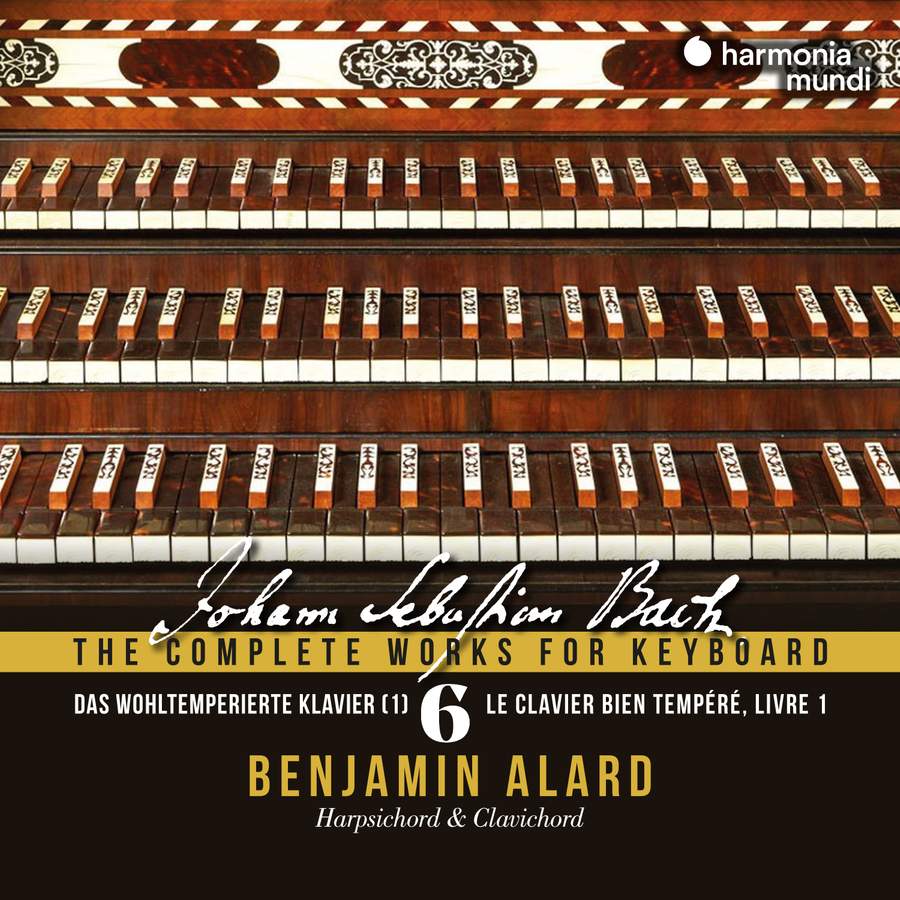JS BACH The Complete Works For Keyboard, Vol. 6 (Benjamin Alard)
View record and artist detailsRecord and Artist Details
Genre:
Instrumental
Label: Harmonia Mundi
Magazine Review Date: 05/2022
Media Format: CD or Download
Media Runtime: 161
Mastering:
DDD
Catalogue Number: HMM90 2466-68

Tracks:
| Composition | Artist Credit |
|---|---|
| (Das) Wohltemperierte Klavier, '(The) Well-Tempered Clavier, Movement: Book 1 BWV846-869 |
Johann Sebastian Bach, Composer
Benjamin Alard, Harpsichord |
Author: Jed Distler
Volume 6 in Benjamin Alard’s cycle covering JS Bach’s complete keyboard output brings us The Well-Tempered Clavier, Book 1. It’s played on a triple-manual harpsichord made by Hieronymus Albrecht Hass in Hamburg in 1740, equipped with five sets of strings that lend themselves to Alard’s imaginative exploration of registrations and combinations of sound.
Most Book 1 recordings follow Bach’s ascending half-step major and minor key sequence. Alard, instead, sequences the Preludes and Fugues around the cycle of fifths: he follows the C major pair with the F major, then the D minor followed by the G major, and so on. This unorthodox ordering yields intriguing contrasts and harmonic relationships from piece to piece. For example, the gravitas of the C major Fugue’s stretto textures refreshingly gives way to the F major’s lightness of being, while the G sharp minor pair’s melancholy aura is broken by the C sharp major pieces’ lilting virtuosity. Other similar juxtapositions convince less, such as the traditionally concluding and austere B minor Fugue now dovetailing into the pastoral E major Prelude.
Then again, digitally savvy listeners can determine their own playlists and absorb Alard’s perceptive musicianship any which way. His measured tempo imparts welcome melodic shaping to the E minor Fugue’s toccata-like patterns, while his similarly phrased G major Fugue has plenty of lilt and breathing room. The B flat minor Prelude sounds less poignant and more gloomy when taken down an octave, yet the Fugue’s brighter timbres and alla breve treatment compensate. I also like the way Alard incorporates the lute stop into the B minor Prelude’s registral mix, not to mention his assertive and declamatory C minor Fugue, and how his flexible phrasing of the episodic E flat major Prelude helps characterise the ornaments.
The first disc is given over to the complete Little Clavier Book for Wilhelm Friedemann Bach, which contains some alternate versions of several Book 1 pieces. Here Alard uses a clavichord from 1763 by Johann Adolf Hass, the son of Hieronymus Albrecht. Its intimately plangent sonorities markedly contrast with Book 1’s statuesque harpsichord. As such, Alard often plays more freely and poetically, and takes tasteful advantage of the smaller instrument’s capacity for vibrato and limited dynamic gradation. He finds more expressive warmth in his clavichord reading of the D major Prelude common to Book 1, in contrast to his enchantingly vivified D major Prelude, BWV936. If Alard perfunctorily speeds through the earlier version of the C major Prelude, BWV846a (to prove the superiority of the Book 1 revision we all know and love?), his emphatic accents in the G minor Allemande, BWV836, will entice you on to the dance floor. Yet I keep returning to Alard’s drop-dead gorgeous chorale prelude Wer nur den lieben Gott lässt walten. How he makes that clavichord sing! As before, Harmonia Mundi’s excellent engineering and generous annotations add value to this important cycle. On to Vol 7 and beyond …
Discover the world's largest classical music catalogue with Presto Music.

Gramophone Digital Club
- Digital Edition
- Digital Archive
- Reviews Database
- Full website access
From £8.75 / month
Subscribe
Gramophone Full Club
- Print Edition
- Digital Edition
- Digital Archive
- Reviews Database
- Full website access
From £11.00 / month
Subscribe
If you are a library, university or other organisation that would be interested in an institutional subscription to Gramophone please click here for further information.




